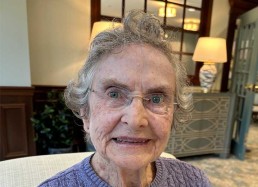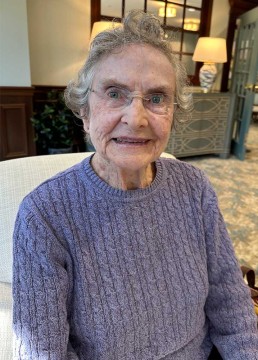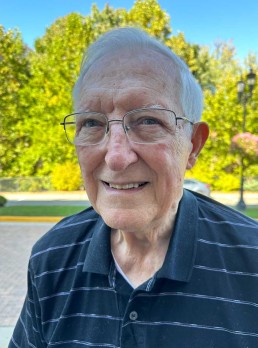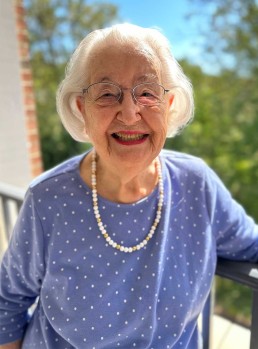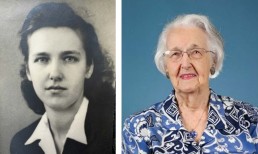Maureen Kennedy
Maureen was born in County Offaly in the Irish midlands 93 years ago. Her parents were teachers, but her mother had to give up her school when her baby Ford had been put up on blocks in the garage and she couldn’t get tires for her bicycle, due to the war. A family escaping Germany lived in their area, and the English wife gave violin lessons to Maureen and her brother, and then taught her when they were able to get a piano.
Education was important and in 1944 she went to boarding school for three years at Mount Sackville Convent by Phoenix Park in Dublin. It is still a vibrant school today, founded by the Sisters of St. Joseph of Cluny, the nuns with the big white hats. Maureen was the leading soprano in the operas and was noticed by the local opera people. However, when her mother became very ill, she had to run the household until her parents passed.
After the war, in the fifties, there was little opportunity for single women to make a living wage. Maureen went to ‘jolly’ London and worked as a bank clerk, where the books had to be balanced by hand every day. Renting a typewriter, she taught herself to type and used her mother’s old textbook to learn Gregg shorthand. A school friend working in NYC invited Maureen to come stay with her, and she arrived in 1963. Maureen remembered her father telling her brother that the oil industry was the place to work and make money.
Several jobs in the big city gave her enough skill to one day confidently walk into Mobil Oil HQ on 42nd Street and apply for a job. Maureen was hired immediately as a legal secretary typing contracts. Reading a flyer circulated only to men, she learned they intended to train employees to be computer programmers. Three years later, she studied the books, passed the qualifying test and started her climb up that ladder.
At NYU she was certified by the Data Processing & Systems Analysis Institute in 1977, became a Registered Professional Nurse at USNY, received a Bachelor of Sciences Degree in Nursing (cum laude) at Hunter College in 1979 and an MBA at Fordham in 1983; all while enjoying life from her apartment with her own piano in Stuyvesant Heights. Maureen had joined the tax department and moved with HQs to Fairfax. Arriving at the airport, she picked up a Ford Taurus, and started a new life that included playing Irish tunes on the fiddle every Saturday with The Breakfast Club in Alexandria. She never lost that Irish lilt in speaking. After 21 years Maureen retired from Mobil as a Tax Accountant.
Renewing her friendship with a doctor in Towson, MD, her first boyfriend in that Irish high school, they traveled back to Ireland many times. From her townhouse condo near the Government Center, Maureen often walked the grounds of The Woodlands and knew this was where she wanted to be when the time came not to be on her own.
Her plans are that one day she will join her parents and sister in that Irish cemetery. Meanwhile, she enjoys the Great Courses classes, breaks out in song whenever she can, and digs in her brain for the answers to the questions along Memory Boulevard on Wednesdays. Starting a career in the early days of women’s liberation, Maureen always has been a woman of great independence and determination to succeed on her own. Well done!

MY BRUSH WITH HISTORY - Dave Smith, USNA Class of 1957
I am sure many classmates have either “brushed” history or “made” history. In my case, I had an early “brush” that was quite interesting—I was present at the meeting of President Eisenhower and Nikita Khrushchev in September 1959, when Khrushchev became the first Soviet leader to visit the United States.
After graduating from the United States Naval Academy, I entered the Air Force in the Technical Intelligence career field. This was during the white heat of the arms race with the Soviets, and just before the Bay of Pigs adventure. The Air Force was, understandably, very interested in Soviet technology, especially their development of fighters, bombers, and missiles. The launch of Sputnik I on October 4, 1957, only sharpened this interest and definitely caught our attention!
So, when Nikita Khrushchev, as the First Secretary of the Communist Party, agreed to make a visit to the United States, we set in motion a broad and detailed intelligence-gathering plan. Several of us went “undercover” as aircraft maintenance technicians working at Idlewild Airport (now J.F. Kennedy). Khrushchev arrived in a new and giant (first time out of the Soviet Union) Tupolev TU-114 turboprop-driven aircraft. He was accompanied by several TU-104 twin-engine jets. We wanted to get as close to these airplanes as possible to record engine stages for subsequent analysis, assess their communications equipment, examine the construction, and overall assess the level of technology. We did a close-up look at the airplanes, and I even worked my way into the belly of one of the TU-104s.
When Khrushchev landed, I was in a follow-me vehicle at the tail of the airplane. I had a front-row seat to watch him deplane and be embraced by President Eisenhower. Since the plane screened off from this event from the terminal, the press was not present. I have never seen a photo of this greeting, but I suspect a White House photographer must have been present. However, there was no picture in the newspapers. Oh, had I thought to have had a camera!
Concurrent with Khrushchev’s visit, the Soviets sent a Sputnik II satellite to New York to show it off in a trade show. So, during the next few days, we conveniently “borrowed” Sputnik II to make a close-up examination of its construction and technology.
From my standpoint, very early in my career, it was a real and successful, cloak and dagger operation that yielded much valuable information on Soviet military technology. However, the Khrushchev visit is probably more notably remembered by his visit to an Iowa farm, and his not being permitted to visit Disneyland in Los Angeles. Sorry!

Betty Gore
Betty was only a toddler when the stock market crashed in 1929. Her father, engaged in the NY markets, lost his clients. She remembers feeling lucky that they were able to stay in their home, but there were no new clothes, only hand-me-downs from her sister or cousins. In 1942 her father was able to get a position with the Department of Agriculture, hugely important at that time, and they moved to Alexandria, VA.
Attending George Washington HS, she worked as a file clerk for the Navy Department the summer she was sixteen. News of the war was limited to the radio and Movie Tone news, but the military presence was the central part of life in the US capitol and its growing suburbs. As a teenager, there was no driving around in cars on weekends because gas was rationed. Near a wartime city, she remembers the East Coast ‘brown outs’ where the shades were closed every night to hide the lights inside.
Another memory is watching from Long Island Sound the German Hindenburg airship, with big red Swastikas painted on it, fly overhead in 1936, and she could see the passengers on the observation deck. She still remembers wondering how the accommodations in that dirigible were arranged and the speculation everywhere as to whether it was on a mission to take pictures of the East Coast shoreline.
Betty graduated from Mary Washington College with a degree in Art. She taught elementary classes for two years in Alexandria. In 1951 she married Herschel Gore. He was a Marine Corps veteran from World War II, serving as a Marine tail-gunner on B-25s during the war in the Pacific. After he graduated from UVA, Betty taught four more years in Charlottesville while he attended medical school. Herschel joined the US Public Health Service with assignments in New York, Greece, and Washington DC. They ended up living in the heart of Fairfax City with their four children.
In 1978 Betty had time for her intense interest in history and art by working as a docent at the Robert E. Lee Boyhood Home in Alexandria. She stayed there for 17 years. In 1981, her schedule added a weekly DC trip to docent at the Hirshhorn Museum. In 1993 she retired as a professional volunteer docent.
Along the way, Betty started water color classes at NOVA. She was active in the McLean Art Club and the Art League of Fairfax. Her travels to art workshops include trips to Italy, Greece, France, Tunisia, Mexico, and many at Springmaid Textile workshops in Myrtle Beach, SC.
Herschel died of cancer in 1989, and in 1993 Betty bought a home near her daughter in Charlottesville. After 14 years there, she moved to an apartment in Oakton VA near her three other children in the area, and six grandchildren.
Betty came to The Woodlands in 2015. Her home is filled with memories: the small Victorian table that meets you at the door is from her grandfather’s antique collection, her grandmother’s gold mirror inside provides one last look before you leave, the brass and copper displays include a mortar and pestle collection, the Marine plaque over one door, and the Public Health Service over another. Most of all, a visitor can enjoy Betty’s own lovely watercolors.

Hank Eckel
Hank Eckel was just an infant when Hitler’s Army marched east past his family’s home at the Baltic Sea near the Polish border. He was born on his mother’s wealthy family estate in the state of Thuringia in a lovely house built as the result of the successful family business. This was only a few towns away from where Martin Luther lived and it became one of the five German states that ended up behind the Iron Curtain. Hank visited the area in 1992 to see dilapidated factories and six families living in his birth house.
Originally from a German colony in South West Africa, Hank’s father was a sailor on the most famous German tall ship (the Gorch Fock) sailing off South America, but was drafted at the beginning of WWII into the Luftwaffe, when it was learned that he was a glider pilot. He was assigned to the airplane and rocket testing grounds at the Baltic Sea shore and the family moved there into a house and his mother’s parents provided a DKW car, a motorcycle with side car, and a riding horse. Everything was wonderful until the end of the war, when the Russians roamed through the area and evacuated Hank, his mother, and his younger brother to the nearby city.
Meanwhile, Hank’s father was taken prisoner by the Russians, but was able to escape and find his family. The home and all belongings were lost. The family decided to move to the western part of Germany. At age 6, Hank remembers that the family, and many other people trying to get away from the Russians, crowded into a cattle train heading west. The family ended up in a small village, living with a farmer. Many people were poor in those days. The Iron Curtain went up. Hank’s mother gave birth to two more boys and she desperately missed her sister and parents, now in East Germany and unreachable. She died at age 30, when he was 10 years old with three brothers.
Hank was able to go to school from age seven to 16 and spoke German, English, and French. He made every effort to improve his school English through frequent interface with American GIs. He applied for work at Standard Oil, Germany, in Frankfurt. His training in all aspects of the company, offices and hand-on at the airport, Main river harbor, trade school, company schooling, etc. led to excellent business knowledge. At 19, he was promoted to the Corporate Headquarters in Hamburg, where he applied for immigration to the USA and also met Christa, whom he married two years later.
A friendship with an American girl in Germany led to her family sponsoring him as an immigrant. Standard Oil (ESSO, Germany), gave him his voyage across the ocean to Canada, from there he took a train to New York city and rode a Greyhound bus to Ohio in late 1959. A survivor of war-torn Germany in rubble and the disgrace of Hitler, he decided to build a new life and career in the United States.
As a 20-year-old immigrant he was drafted into the US Army and moved rapidly to the rank of Staff Sargent. He served a year in Korea, maintaining correspondence with Christa. Her experience as a two-year-old in the war was to seek shelter in the basement of their house with her mother during an air raid, which destroyed the house and all their belongings, leaving them homeless. Her father was traced to Stalingrad, but was never heard from again.
Whenever possible, Hank earned credits in universities, and while stationed in Germany, returned on leave to Ohio to become an American citizen after just three years from the date of his US arrival. Being interested in flying, he attended helicopter flight school and served two years in Vietnam flying helicopters. He had a satisfying, diverse military career, retiring as Colonel with 33 years of service.
Christa retired from Government service as a GS-14 Contract Audit Manager with a Virginia CPA. He and Christa have one daughter, a judge in the PA court system, and two granddaughters.

Jim Wescoat
Jim dropped out of high school and joined the Marines one month after Pearl Harbor. He served as an anti-aircraft machine gunner in the Marine detachment aboard the light cruiser USS Denver, in the Japanese waters of the Southwest Pacific. The most noteworthy single occurrence was when the ship was torpedoed and very nearly sunk, dead in the water with the engine room blown out. Managing to stay afloat, an ocean-going tug towed the Denver back to Guadalcanal.
Jim served 45 months as a Marine, ending as an artillery buck sergeant preparing for the invasion of Japan. Hiroshima ended the war and our servicemen headed home. His service opened new opportunities for doing well in life, and he immediately worked to get the high school diploma he sorely lacked. Determined to get an education, on the GI Bill, Jim received his degree in Mechanical Engineering from the University of Virginia. A friend had introduced him to the love of his life, Bonna, and they entered his life in the petroleum industry.
Jim’s professional service involved working for several companies at their refining and marketing facilities. The most recent and rewarding assignment involved making numerous short duration inspection and consultation visits to each of the Mobil International marketing terminals and refineries. Retiring at 75, Jim enjoyed volunteering at the Lamb Center and at schools.
Jim and his late wife, Bonna, were blessed with 72 years together and a close-knit family of four married children, eight grandchildren and one very new great grandson. While geographically located along both coasts, the Mid West, Europe and Africa, the bonds are still strong. With Bonna’s invaluable guidance and encouragement, all are happily on track following his or her own North Star. Jim, Bonna, and their late chocolate lab, Lucy, came to The Woodlands in 2018. Now at 101+ years, Jim is fully comfortable with modern technology, following his sailing son via satellite, and gladly will show you pictures of his wonderful new great-grandson.

Anny DeBoeck
Anny Is proud to be 97 years old and was born and raised in Antwerp, Belgium. During the war she went to a boarding school in Brussels. When the railroads were bombed, she, along with four other girls, rode their bicycles four and a half hours to get home for the weekend. They often were tooted at by the German soldiers passing by.
Totally overcome by German bombing that blew out the windows and doors of her home, her family decided to stay in Antwerp. The Belgians endured food and other shortages, loss of their private vehicles, and the governing by Germans.
Her older brother, Pierre, served a short time in the Belgian army, fought in France, and was captured, but was able to go home because his captors couldn’t wait for the trains to take away prisoners of war to Germany.
Her favorite war story is when she played Saint Nicholas dressed in a bishop’s robes and a high mitre hat on a school stage when an air raid took place. Everyone took shelter except for Anny in that cumbersome outfit restraining her. And after all – she was St. Nicholas!!
Anny married Jean DeBoeck in the Belgian foreign service, who was sent to DC to work on the Marshall Plan. Six years later he was hired by the World Bank. During that time, Anny taught the Dutch language at the Foreign Service Institute. They became US citizens after his retirement. She visited Belgium every other year until about six years ago. She thinks in French, still enjoys reading French books, and sings heartily in French, when possible, in living room musical nights at The Woodlands.
Anny has a son and a daughter living close by, six grandchildren, and 14 great-grandchildren. They have big holiday gatherings! Prior to coming to The Woodlands as an original resident 14 years ago, Anny lived in Annandale.

Kay Gilbert
“One of the unexpected benefits of moving to The Woodlands senior living community is the opportunity to meet many wonderful people, each of whom has a rich story to tell about their life experiences. The warm and welcoming reception new residents receive when they move to The Woodlands is almost like discovering long-lost family members.
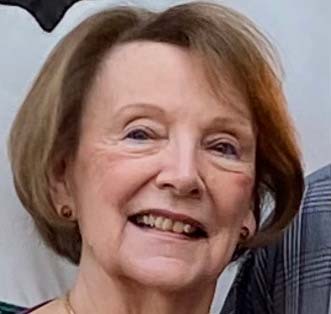 When my husband John and I first came, eating dinner with our new Woodlands neighbor led to their sharing memories of their earlier years. As I listened to their stories, I asked questions, followed up, and wrote down what they shared. Many of them lived at a time during World War II. The ‘Our Story’ series (or column) provides an opportunity for each of us to share some of our wartime experiences, whether serving in World War II, Korea, Vietnam or the Gulf war.
When my husband John and I first came, eating dinner with our new Woodlands neighbor led to their sharing memories of their earlier years. As I listened to their stories, I asked questions, followed up, and wrote down what they shared. Many of them lived at a time during World War II. The ‘Our Story’ series (or column) provides an opportunity for each of us to share some of our wartime experiences, whether serving in World War II, Korea, Vietnam or the Gulf war.
For example, do your grandchildren know where you were during World War II? Do they know you rode in a cattle car as a displaced person sent to live on a farm? Do they know their grandfather escaped persecution by the Nazis and arrived in America before many of his family died in concentration camps of the Holocaust? Do they know you were a teenager before tasting meat? Do they know your ship was torpedoed in the Pacific? Do they know what you were doing during an air raid?
Our Woodlands senior residents have many stories to tell about their World War II and other experiences where they lived in Belgium, Switzerland, and Germany, living in the bombed cities, their cars confiscated by the military, and food, clothing and petrol were rationed.
As a child born in 1938, I remember the nightly black outs, with the streets patrolled, the ration books, saving big balls of tinfoil, and buying victory stamps for bonds at school; the soldiers who came home to visit in their uniforms and were welcomed by their family and friends. My uncle was an engineer on a Pacific Island and Aunt Aimee would point out a spot on the living room globe and ask if we saw his feet sticking out.
All sorts of stories, whether wartime or not, should be shared with our children and grandchildren so they may understand more about our times growing up. How many times have you wished you had asked more questions of your parents? Think about writing your own story. You, your family and even your fellow neighbors at The Woodlands might be richer and more appreciative of the past and present because of your story.
The Woodlands Senior Residents Cover Many Generations
Whether you are part of the Silent Generation born between 1925-45 or a Baby Boomer born between 1946-64, part of the surge to the US population after World War II, each of us has a unique story to share. There are a few among us who lived in war-torn Europe whose experiences are different from American children.
In the coming months, I welcome you to have a cup of something and let’s write your own story to share.”


